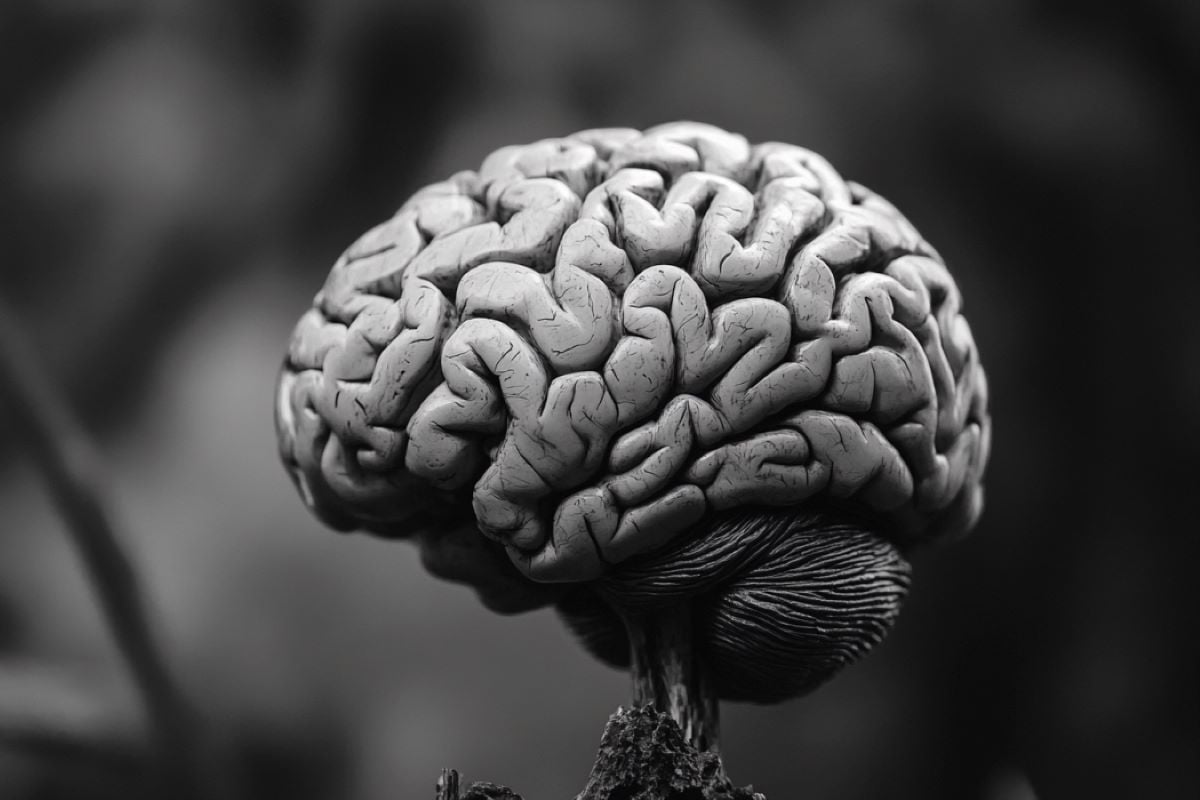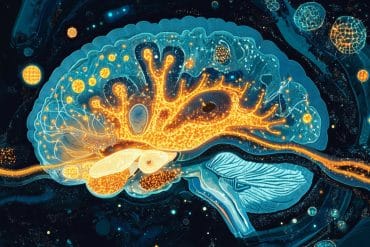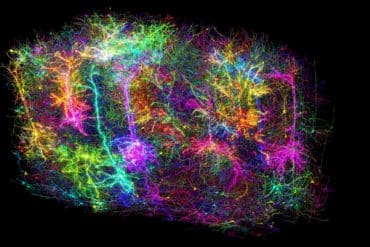Summary: Researchers have discovered how a lipid molecule, BMP, crucial for brain function, is produced, potentially opening new doors for treating neurodegenerative diseases like Alzheimer’s and frontotemporal dementia. Two enzymes, PLD3 and PLD4, were found to catalyze the formation of BMP by changing the molecule’s “handedness,” allowing it to remain stable in lysosomes where other lipids are broken down.
This finding sheds light on lipid regulation in the brain, helping to explain the buildup of toxic molecules in conditions like dementia. The research offers a promising new direction for understanding brain health and developing future therapies.
Key Facts:
- BMP, a lipid vital for brain health, is produced by PLD3 and PLD4 enzymes.
- These enzymes change BMP’s “handedness,” allowing it to stabilize in lysosomes.
- Understanding BMP production could lead to therapies for Alzheimer’s and dementia.
Source: HHMI
Scientists have gained a deeper understanding of a molecule that regulates lipid levels in the brain. This breakthrough could eventually lead to treatments for diseases like frontotemporal dementia and Alzheimer’s disease.
The findings are published in the journal Cell.
How do you make a fatty molecule that is involved in breaking down other fats in the brain, yet doesn’t get destroyed itself? It’s a question that has wracked scientists’ brains for half a century.

BMP, or bis(monoacylglycerol)phosphate, is a phospholipid that is located in lysosomes—the cell’s garbage bins.
“BMP is a co-factor for degradation, but itself is very, very stable, and it has an unusual chemistry,” says Howard Hughes Medical Institute Investigator Tobias Walther. “As a consequence, nobody knew how this is made.”
In the new study, Walther and Robert Farese, Jr.’s team at the cell biology program of the Sloan Kettering Institute reports that two enzymes, phospholipases D3 and D4 (PLD3 and PLD4), are needed to make BMP in lab assays as well as in human cells and animal models.
For more than 15 years, Walther and Farese’s lab has investigated frontotemporal dementia (FTD), the disease that actor Bruce Willis was diagnosed with in 2023. It affects both the frontal and temporal lobes of the brain, which are responsible for personality, judgment, and speech.
FTD is the most common cause of dementia in people under the age of 60, and it has no known cure or treatment.
In previous work, the researchers discovered that FTD patients had elevated levels of gangliosides, a type of lipid that is attached to a sugar, in their brains. It turned out that these molecules were building up because of a problem with breaking them down.
“That’s when we got really interested in this BMP molecule, and we found that it was extremely low in FTD brains,” says Farese.
High levels of gangliosides are toxic, and changes in BMP activity are associated with neurodegenerative diseases, suggesting that keeping ganglioside amounts in check is important for healthy brain function.
Mirror, mirror on the wall
As molecules go, BMP is peculiar, says Walther.
“Molecules have a pattern that is either like a left or right hand that is identical at one level, but one is a mirror image of the other,” he says.
Lipids and phospholipids are almost always in the “R” configuration, but BMP is one of the rare phospholipids that is in the opposite form, called “S.” In fact, “handedness” can occur in two places in BMP, and both are in the S form.
The S handedness of BMP is what makes it so stable in the lysosome, when all of the other lipids—which are R—are destroyed. But the 50-year-old question is—if lipids are R, how does one of them become S?
Changing a molecule’s handedness is no simple feat and it rarely occurs, says Shubham Singh, the postdoctoral fellow at the Sloan Kettering Institute who led the study.
“Everything in lipid biochemistry starts from one molecule called glycerol 3-phosphate, and it is R,” says Singh.
“So, at what step do you convert R to S, or right hand to left hand, to make BMP?”
Swap meet
Singh and colleagues observed that human cells swap, or exchange, a glycerol between two different molecules to make the S form of BMP in a reaction called transphosphatidylation.
Then, by poring through protein sequences for enzymes that look like they might interact with lipids, Singh decided to test phospholipase D enzymes.
Through a series of experiments, the researchers concluded that PLD3 and PLD4 catalyze the reaction. Bumping up PLD3 or PLD4 expression boosted BMP levels, and mutations that abolish their activity resulted in lower BMP levels.
Interestingly, PLD3 mutations that cause spinocerebellar ataxia 46, a rare neurodegenerative disease, or that increase Alzheimer’s risk also reduce BMP synthesis. Similar results on brain lipids were found when PLD3 was knocked out in mice.
“The paper’s findings that these two related enzymes, PLD3 and PLD4, produce BMP fills in a significant piece in the BMP puzzle, and these enzymes do so in an elegant way that results in inversion of the stereochemistry, or handedness, of parts of the molecule,” says Jeremy Baskin, a cell biologist at Cornell University, who was not involved in the work.
Baskin adds that the study expands the field’s understanding of PLD3 and PLD4, because unlike other members of the phospholipase D class, the functions of these two enzymes were not well understood.
In fact, he says that PLD3 and PLD4 were once thought to only break down nucleic acids, but now they appear to have a new role in making a lipid. Walther says that was just one of the surprising results.
“We were also surprised because other people had reported that another enzyme could make BMP,” he says. That enzyme could make BMP, but it was the wrong stereochemical form.
Now that the team knows more about a crucial step in BMP synthesis, they are looking at the lipid’s role in other neurodegenerative diseases. And although they haven’t considered therapies based on their findings yet, it is possible that such approaches could help patients in the future.
In the end, Walther explains, the work is a demonstration of the value of basic research.
“It really took us sitting down and drawing out the pathways with persistence and a little bit of serendipity to go after this,” he says.
“There are so many of these unturned stones and fundamental discoveries left to be made.”
About this dementia and neurology research news
Author: Tobias Walther
Source: HHMI
Contact: Tobias Walther – HHMI
Image: The image is credited to Neuroscience News
Original Research: Open access.
“PLD3 and PLD4 synthesize S,S-BMP, a key phospholipid enabling lipid degradation in lysosomes” by Tobias Walther et al. Cell
Abstract
PLD3 and PLD4 synthesize S,S-BMP, a key phospholipid enabling lipid degradation in lysosomes
Bis(monoacylglycero)phosphate (BMP) is an abundant lysosomal phospholipid required for degradation of lipids, particularly gangliosides. Alterations in BMP levels are associated with neurodegenerative diseases.
Unlike typical glycerophospholipids, lysosomal BMP has two chiral glycerol carbons in the S (rather than the R) stereo-conformation, protecting it from lysosomal degradation. How this unusual and yet crucial S,S-stereochemistry is achieved is unknown.
Here, we report that phospholipases D3 and D4 (PLD3 and PLD4) synthesize lysosomal S,S-BMP, with either enzyme catalyzing the critical glycerol stereo-inversion reaction in vitro.
Deletion of PLD3 or PLD4 markedly reduced BMP levels in cells or in murine tissues where either enzyme is highly expressed (brain for PLD3; spleen for PLD4), leading to gangliosidosis and lysosomal abnormalities.
PLD3 mutants associated with neurodegenerative diseases, including risk of Alzheimer’s disease, diminished PLD3 catalytic activity.
We conclude that PLD3/4 enzymes synthesize lysosomal S,S-BMP, a crucial lipid for maintaining brain health.






